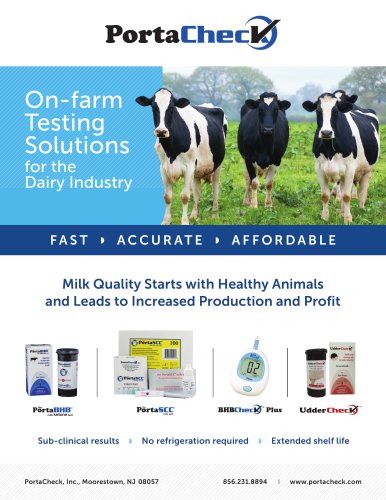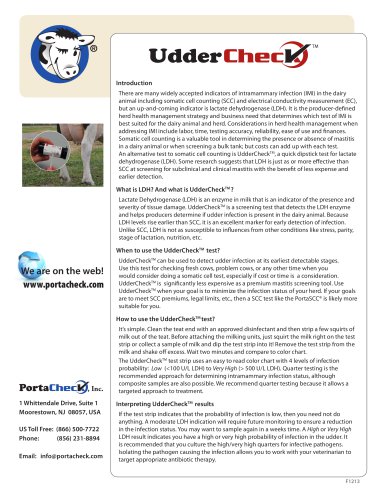 Website:
PortaCheck
Website:
PortaCheck
Group: Veterinary
Catalog excerpts

Suggested Protocols: Colostrum Management Colostrum should be collected into a clean container. After collection, colostrum should be refrigerated immediately if not fed right away. Rapid cooling is essential in preventing growth of bacteria that double in number within 30 minutes at room temperature. Use clean bottles or drenches when feeding calves as opposed to letting them suckle. A cow’s udder is not clean and bottle or drench feeding ensures adequate ingestion of colostrum. Feed 6 – 8 quarts of colostrum within the first 24 hours of life —with the first feeding ̶ of 2 – 4 quarts within 2 hours after birth. Colostrum should be of high quality: low somatic cell count (<200,000), low bacteria. count (<100,000 cfu/mL), and free of odor or abnormal discoloration. Colostrum IgG content ≥ 50 mg/mL for dairy cattle and > 100 mg/mL for beef cattle indicates high quality for passive transfer. Simple, calf-side lateral flow test to screen for IgG passive transfer. Uses whole blood—no need to separate. Affordable and convenient. Results in 10 minutes! Use with PortaCheck 10 µL Pipetter (sold separately). Easy cow-side quantitative test to screen for colostrum quality and IgG. Results on Apple smartphone app in 10 minutes. Key Points To ensure quality colostrum, milking udder prep and sanitary collection is paramount. First colostrum feeding (2 – 4 qts) within 2 hours of birth. A calf’s ability to absorb IgG rapidly declines and is complete within 18 – 24 hours. A calf should consume 6 – 8 quarts of high quality colostrum within its first 24 hours of life. Monitoring Passive Transfer of IgG Intended Use: This test is intended solely as an on-farm screening test. Consult a veterinarian before starting any treatment. Your Partner in Milk Quality and Animal Health 1 Whittendale Drive, Suite
Open the catalog to page 1
What is IgG? IgG is an important immunoglobulin (protein, also referred to as an antibody) that binds to and destroys pathogens and then later recognizes them to defend the body against infection (immune response). There are 3 main immunoglobulins in the body: IgG, IgA, and IgM. IgG accounts for approximately 85% of immunoglobulins while IgA and IgM make up the remaining 15%. IgG is the primary immunoglobulin involved in immune response against bacterial and viral infection. Why Test for IgG? A calf’s only defense comes from colostrum since no antibodies are transferred through the...
Open the catalog to page 2All PortaCheck catalogs and technical brochures
-
Glucose Monitoring
2 Pages
-
On-farm testing solutions
4 Pages
-
PortaSCC
2 Pages
-
UdderCheck™
1 Pages
-
PortaBHB
1 Pages
Archived catalogs
-
PortaCheck Products
4 Pages








